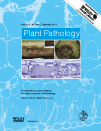Crop Centre in Print
Please find the latest journal publications from the Crop Centre listed below.
For a full list of publications from the School of Life Sciences please visit the Latest Journal Publications
Resistance to a highly aggressive isolate of Sclerotinia sclerotiorum in a Brassica napus diversity set
 Andrew Taylor, Emma Coventry, Julie Jones, John Clarkson
Andrew Taylor, Emma Coventry, Julie Jones, John Clarkson
Sclerotinia stem rot (SSR) of oilseed rape (OSR, Brassica napus), caused by Sclerotinia sclerotiorum (Lib.) de Bary, is a serious problem in the UK and worldwide.
As fungicide-based control approaches are not always reliable, identifying host resistance is a desirable and sustainable approach to disease management.
This research initially examined the aggressiveness of 18 Sclerotinia isolates (17 S. sclerotiorum, one S. subarctica) on cultivated representatives of B. rapa, B. oleracea and B. napus using a young plant test. Significant differences were observed between isolates and susceptibility of the brassica crop types, with B. rapa being the most susceptible. Sclerotinia sclerotiorum isolates from crop hosts were more aggressive than those from wild buttercup (Ranunculus acris). S. sclerotiorum isolates P7 (pea) and DG4 (buttercup), identified as ‘aggressive’ and ‘weakly-aggressive’ respectively, were used to screen 96 B. napus lines for SSR resistance in a young plant test.
A subset of 20 lines were further evaluated using the same test and also in a stem inoculation test on flowering plants. A high level of SSR resistance was observed for five lines and, although there was some variability between tests, one winter OSR, (Line 3, Czech Republic) and one rape kale (line 83, UK) demonstrated consistent resistance. Additionally, one swede (line 69, Norway) showed an outstanding level of resistance in the stem test. Resistant lines also had fewer sclerotia forming in stems.
New pre-breeding material for the production of SSR resistant OSR cultivars relevant to conditions in the UK and Europe has therefore been identified.
Impact of fresh root material and mature crop residues of oilseed rape (Brassica napus) on microbial communities associated with subsequent oilseed rape
Amanda J Bennett; Sally Hilton; Gary D Bending; David Chandler; Peter Mills
Glasshouse bioassays were conducted to assess the impact of different inputs of oilseed rape plant material on soil and rhizosphere microbial diversity associated with subsequently grown oilseed rape (Brassica napus) plants. The first bioassay focussed on the effect of oilseed rape rhizodeposits and fresh detached root material on microbial communities. In the second glasshouse experiment, the effect of incorporating mature, field-derived oilseed rape crop residues (shoots and root material) on microbial communities associated with subsequently grown oilseed rape was investigated. Molecular analyses revealed that O. brassicae dominated the rhizosphere fungal community, despite not being prevalent in either the residue material or soil fungal communities.
Biology and Fertility of Soils. November 2014
Detection of Potato Storage Disease via Gas Analysis: A Pilot Study Using Field Asymmetric Ion Mobility Spectrometry
 Massimo Rutolo, James A Covington, John Clarkson, Daciana Iliescu
Massimo Rutolo, James A Covington, John Clarkson, Daciana Iliescu
Soft rot is a commonly occurring potato tuber disease that each year causes substantial losses to the food industry. This article explores the possibility of early detection of the disease via gas/vapor analysis, in a laboratory environment, using a recent technology known as FAIMS (Field Asymmetric Ion Mobility Spectrometry).
Sensors 2014, 14(9), 15939-15952; doi:10.3390/s140915939
Horticulture: Plants for People and Places
 Dixon, G., Aldous, David E. (Eds.)
Dixon, G., Aldous, David E. (Eds.)
This volume provides detailed considerations of the scientific, managerial and technological concepts which underpin Environmental Horticulture. This discipline returns horticulture to its original values required for the design, husbandry and management of macro- and micro-landscapes and their constituent parts.
Expert internationally acclaimed authors describe:- Horticulture and the Environment, Woody Ornamentals, Herbs and Pharmaceuticals, Urban Greening, Rural Trees, Urban Trees, Turfgrass Science, Interior and External Landscaping, Biodiversity, Climate Change and Organic Production.
Warwick Crop Centre contributions:
Rob Lillywhite: Horticulture and The Environment, chapter 16, pg 603
Rosemary Collier: An Assessment of The Effects of Climate Change on Horticulture, chapter 25, pg 817
These subjects are united by considerations of the needs for the sustainable use of resources and careful conservation applied wherever Horticulture, natural flora and fauna, and the environment coincide.
Horticulture: Plants for People and Places: Vol 2, 2014 XXI, 347 p. 65
Transcriptome and methylome profiling reveals relics of genome dominance in the mesopolyploid Brassica oleracea
 Isobel AP Parkin, Chushin Koh, Haibao Tang, Stephen J Robinson, Sateesh Kagale, Wayne E Clarke, Chris D Town, John Nixon, Vivek Krishnakumar, Shelby L Bidwell, France Denoeud, Harry Belcram, Matthew G Links, Jérémy Just, Carling Clarke, Tricia Bender, Terry Huebert, Annaliese S Mason, Chris J Pires, Guy Barker, Jonathan Moore, Peter G Walley, Sahana Manoli, Jacqueline Batley, Dave Edwards, Matthew N Nelson, Xiyin Wang, Andrew H Paterson, Graham King, Ian Bancroft, Boulos Chalhoub and Andrew G Sharpe
Isobel AP Parkin, Chushin Koh, Haibao Tang, Stephen J Robinson, Sateesh Kagale, Wayne E Clarke, Chris D Town, John Nixon, Vivek Krishnakumar, Shelby L Bidwell, France Denoeud, Harry Belcram, Matthew G Links, Jérémy Just, Carling Clarke, Tricia Bender, Terry Huebert, Annaliese S Mason, Chris J Pires, Guy Barker, Jonathan Moore, Peter G Walley, Sahana Manoli, Jacqueline Batley, Dave Edwards, Matthew N Nelson, Xiyin Wang, Andrew H Paterson, Graham King, Ian Bancroft, Boulos Chalhoub and Andrew G Sharpe
Brassica oleracea is a valuable vegetable species that has contributed to human health and nutrition for hundreds of years and comprises multiple distinct cultivar groups with diverse morphological and phytochemical attributes. In addition to this phenotypic wealth, B. oleracea offers unique insights into polyploid evolution, as it results from multiple ancestral polyploidy events and a final Brassiceae-specific triplication event.
This publication represents the findings of the international Brassica oleracea genome sequencing consortium. The data generated offers the best quality assembled B. oleracea genome to date, and serves to emphasise the strong international profile of Warwick in Brassica research.
http://genomebiology.com/2014/15/6/R77/abstract
Genome Biology 2014, 15:R77
doi:10.1186/gb-2014-15-6-r77
